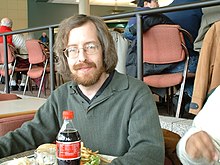Michael R. Douglas
Michael R. Douglas (born November 19, 1961 in Baton Rouge ) is an American theoretical physicist who studies string theory.
Douglas is the son of math professor Ronald G. Douglas . Douglas studied physics at Harvard University with a bachelor's degree in 1983 and received his doctorate in 1988 with John Schwarz at Caltech . As a post-doctoral student , he was an Enrico Fermi Fellow at the University of Chicago in 1988/89 and then with Daniel Friedan and Stephen Shenker at Rutgers University at the newly founded New High Energy Theory Center (NHETC). In 1990 he became an assistant professor there and in 1995 an associate professor. In 1990 he was a visiting scientist at the École normal supérieure and the Artificial Intelligence Laboratory at MIT . At MIT he was part of Gerald J. Sussman's team building a special computer for calculations in celestial mechanics (Digital Orrery). In 1997/98 he switched to the IHES in France as a professor for a year , where he has been a visiting fellow since 1999. In 1999 he returned to Rutgers University, where he became director of the NHETC in 2000. In 2008 he went to the newly founded Simons Center for Geometry and Physics at SUNY .
Douglas is known for his involvement in the development of the matrix models of superstring theory ( M-theory ), for research on D- branes and non-commutative geometry in string theory. He is also concerned with the string landscape, the construction of vacuums in string theory and the derivation of the statistical distribution of its observable consequences. Since his time at MIT, he has also been interested in computer applications in physics.
In 1991 he was a Sloan Research Fellow and received a Presidential Young Investigator Award . In 2000 he received the Sackler Prize in theoretical physics. In 2002 he was invited speaker at the International Congress of Mathematicians in Beijing (Dirichlet branes, homological mirror symmetry and stability).
He has been married since 1997 and has two children. His wife Nina writes and illustrates children's books.
Web links
- Homepage
- Michael R. Douglas in the Mathematics Genealogy Project (English)
Individual evidence
- ↑ Life and career data according to American Men and Women of Science , Thomson Gale 2004
| personal data | |
|---|---|
| SURNAME | Douglas, Michael R. |
| BRIEF DESCRIPTION | American physicist |
| DATE OF BIRTH | November 19, 1961 |
| PLACE OF BIRTH | Baton Rouge |
